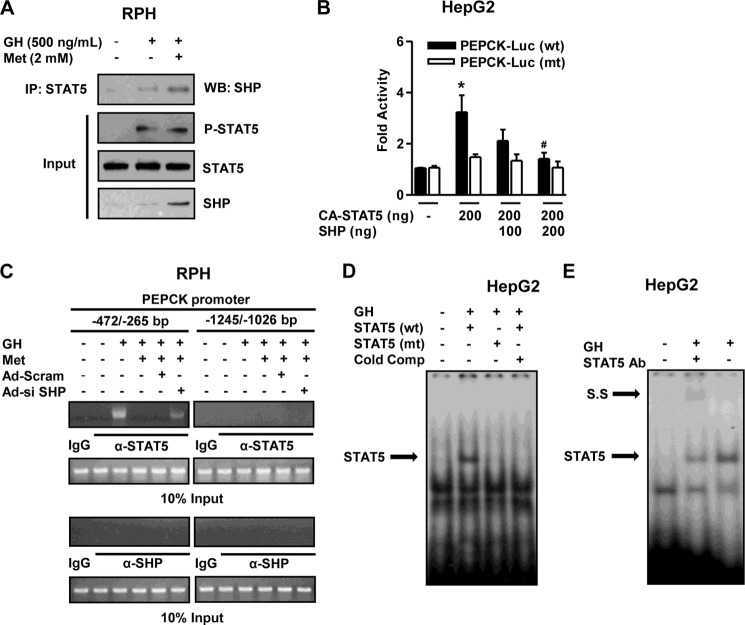FIGURE 5.
SHP physically interacts with STAT5. A, co-immunoprecipitation (IP) assays with RPHs indicated an association between SHP and STAT5. Protein extracts from primary hepatocytes were immunoprecipitated using anti-STAT5 antibody and then blotted with SHP antibody. Expression of phospho-STAT5, STAT5, and SHP from 10% of lysates were analyzed by Western blotting (WB) with specific antibodies. B, HepG2 cells were co-transfected with the wild type, mutant form of the PEPCK gene promoter, CA-STAT5, and SHP, as described in Fig. 3E. Luciferase activity was normalized to β-galactosidase activity to correct for transfection efficiency. C, RPHs were infected for 36 h with Ad-si SHP (multiplicity of infection of 60) and Ad-Scram (multiplicity of infection of 60) and then treated with either GH (500 ng/ml) or metformin (Met, 2 mm) treatment at the indicated concentration for the ChIP assay. Input represents 10% of purified DNA in each sample. Cell extracts were immunoprecipitated with STAT5 (nonphosphorylated STAT5) and SHP antibodies, and purified DNA samples were used for PCR with primers binding to the specific proximal (left panel) and nonspecific distal (right panel) regions on the PEPCK gene promoter. All of the data are representative of at least three independent experiments. D, nuclear extracts were prepared from HepG2 cells treated with GH (500 ng/ml). For EMSA, protein-DNA complexes (arrow) were analyzed by 4% PAGE, followed by autoradiography. Successive cold competitor (Cold Comp) was performed with unlabeled oligonucleotide. E, nuclear extracts were prepared from HepG2 cells treated with GH (500 ng/ml). For supershift (S.S) analysis, protein was preincubated with the indicated antibody and then incubated with labeled oligonucleotides from −316 to −296 of the PEPCK gene promoter. The protein-DNA complexes (arrows) were analyzed by EMSA. *, p < 0.05 (Student's t test); #, p < 0.05 compared with untreated control and GH-treated cells (Student's t test or ANOVA).

